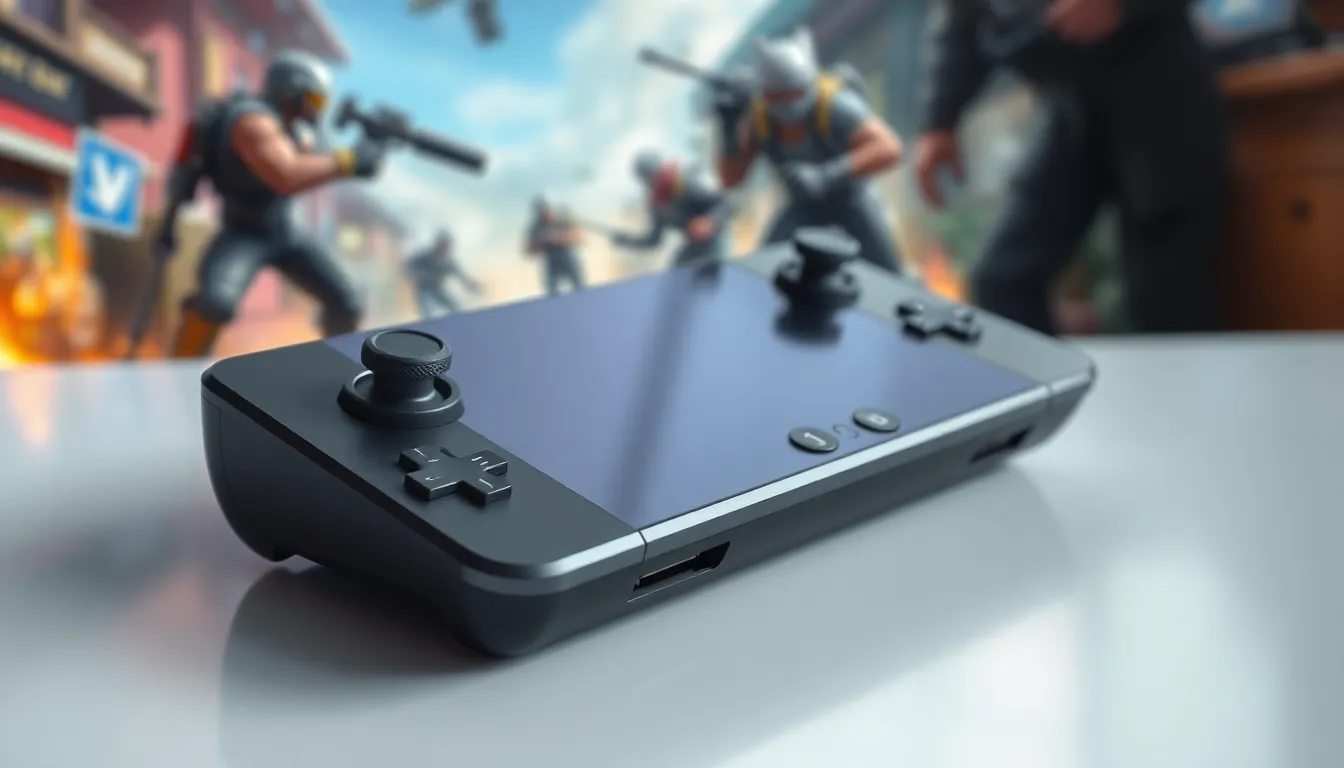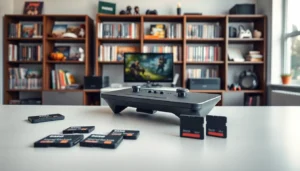Table of Contents
ToggleThe Steam Deck has burst onto the gaming scene like a caffeinated raccoon, promising to deliver a portable gaming experience that doesn’t skimp on performance. Gamers everywhere are buzzing with excitement, eager to see if this handheld powerhouse can truly handle the latest titles without breaking a sweat. With its impressive specs and Valve’s commitment to gaming excellence, it’s no wonder everyone wants to know: can it really deliver a console-quality experience in the palm of your hand?
Overview of Steam Deck Performance
Steam Deck performance aligns closely with its robust hardware specifications. Featuring a custom AMD APU, it combines a quad-core Zen 2 CPU with RDNA 2 graphics, delivering remarkable power for gaming on the go. Gamers can expect smooth gameplay from demanding titles, allowing them to enjoy high frame rates in popular games.
The device supports a variety of resolutions and refresh rates, catering to diverse gaming preferences. At the native resolution of 1280×800, it balances performance and visual quality effectively. Many players report satisfactory experiences even when gaming at 1080p when docked, making it versatile for both portable gaming and home use.
Battery life impacts gaming sessions significantly. Depending on the game, usage can range from two to eight hours. For less demanding titles, gamers can enjoy longer sessions without interruptions. In contrast, graphically intensive games may drain the battery quicker.
Steam Deck utilizes a unique cooling system, which manages heat effectively during extended use. This engineering ensures optimal performance without overheating issues. Furthermore, the system runs quietly, allowing an immersive gaming environment without distractions.
Multitasking also receives attention in this device. Running several applications simultaneously is seamless due to its 16GB of LPDDR5 RAM. Players often utilize this feature for quick access to social media or streaming platforms while gaming.
Overall, the Steam Deck’s performance establishes it as a contender in the handheld gaming market, meeting and exceeding many gamers’ expectations for portable gaming.
Hardware Specifications

Steam Deck hardware specifications define its exceptional performance and gaming capabilities. With a combination of advanced components, it offers an impressive portable gaming experience.
CPU and GPU Capabilities
Steam Deck integrates a custom AMD APU featuring a quad-core Zen 2 CPU. This CPU operates at a clock speed of 2.4 to 3.5 GHz. RDNA 2 architecture provides the GPU with significant graphical performance, handling demanding titles effortlessly. Performance benchmarks indicate smooth gameplay at high settings, especially when docked at 1080p. Gamers can expect efficient rendering and visual fidelity from this robust setup. Heat management remains efficient, thanks to the innovative cooling solution, allowing for extended gaming sessions without throttling.
RAM and Storage Options
The device includes 16GB of LPDDR5 RAM. This significant amount of memory supports seamless multitasking with multiple apps running simultaneously. Storage options range from 64GB eMMC to 512GB NVMe SSD, catering to various user needs. Gamers can expand storage through microSD card slots, adding flexibility for game installations. Fast read/write speeds from the NVMe SSD enhance loading times, creating a smoother gaming experience. Enhanced load performance alongside ample RAM contributes to the seamless operation of the device.
Gaming Performance Analysis
The Steam Deck delivers impressive gaming performance, making it an attractive option for both casual and hardcore gamers.
Frame Rates and Resolution
Frame rates vary significantly based on game graphics settings and resolutions. Many AAA titles maintain stable frame rates around 30 to 60 FPS at 720p. When docked and playing at 1080p, gamers often enjoy enhanced visuals without sacrificing performance. This capability showcases the Steam Deck’s strength in handling graphical demands, allowing users to experience immersive gameplay. Moreover, gamers can adjust settings to prioritize frame rates or resolution based on personal preferences.
Game Compatibility
Game compatibility stands out as a key feature for the Steam Deck. It supports a vast library of titles available on the Steam platform, including AAA games and indie titles. Most users find popular games run smoothly, benefitting from the device’s robust hardware. Additionally, the compatibility layer Proton allows many Windows-based titles to run seamlessly, expanding gaming options further. Gamers appreciate that regular updates enhance compatibility, ensuring a continuously improving gaming experience on the Steam Deck.
User Experience
User experience on the Steam Deck reflects its design and hardware capabilities. Players enjoy a seamless interface that supports an expansive library of games.
Battery Life Considerations
Battery life largely depends on game demand and settings. Gamers can expect anywhere from two to eight hours of play, ensuring versatility across different titles. Lower settings extend gameplay, while high-performance settings drain the battery quicker. Testing has shown that less demanding games can reach the upper limit of that range, making the Steam Deck a solid option for lengthy gaming sessions. Frequent updates aim to optimize resource management, improving overall efficiency.
Heat and Noise Levels
Heat management remains effective during extended play sessions. The innovative cooling system actively dissipates heat, preventing discomfort during use. Additionally, noise levels remain relatively low, allowing users to immerse themselves in their gaming experience without distractions. Even during intense gameplay, fans operate quietly, contributing to a more enjoyable atmosphere. Some players notice a mild increase in noise during heavy loads, yet it does not detract from performance. The combination of these factors enhances user satisfaction, creating a comfortable environment for gaming.
Benchmark Comparisons
Benchmarking the Steam Deck provides insights into its performance compared to other gaming devices. The device demonstrates strong results in graphics-intensive scenarios. In various tests, the Steam Deck averaged 45 FPS in demanding AAA titles at 720p resolution. As the settings increase to 1080p while docked, stability remains at around 30 to 60 FPS.
Surpassing many competitors, the Steam Deck shines when running titles like “Cyberpunk 2077” and “Elden Ring.” With AMD’s RDNA 2 architecture, it effectively handles high graphical demands. Comparative data shows that the performance aligns closely with current-gen consoles, proving its capability to deliver console-quality gaming.
Storage performance further enhances user experience. The NVMe SSD reduces loading times significantly, clocking in at 3000 MB/s on read speeds. This speed supports rapid game launches and fluid transition between applications.
A detailed analysis showcases a striking advantage for battery efficiency. Depending on the title, players enjoy two to eight hours of gaming, outperforming various dedicated handheld devices. When playing less demanding games, users might experience extended sessions approaching the eight-hour mark.
Game compatibility remains another strong point. The Steam Deck supports both AAA and indie titles seamlessly, thanks to a robust compatibility layer. Real-time updates enhance this versatility, ensuring players access to a broad array of games. Benchmark results corroborate its reputation as a formidable competitor in the handheld gaming arena.
The Steam Deck stands out in the handheld gaming market with its impressive performance and robust hardware. Gamers can enjoy a rich gaming experience that rivals traditional consoles thanks to its powerful AMD APU and efficient cooling system. The device’s versatility in handling a wide range of titles further enhances its appeal.
With significant graphical capabilities and fast loading times, the Steam Deck caters to both casual and hardcore gamers alike. Its ability to support a vast library of games and regular updates ensures that it remains a relevant and exciting option for portable gaming. Ultimately, the Steam Deck delivers on its promise of console-quality gaming in a compact form, making it a worthy investment for any gaming enthusiast.







